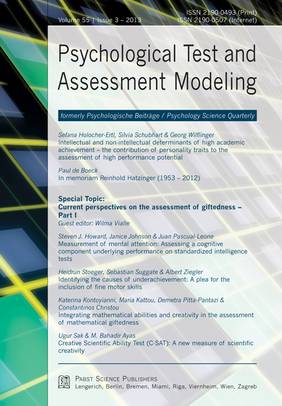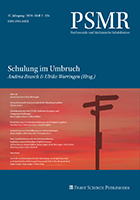Psychological Test and Assessment Modeling: The terms giftedness and intelligence are widely used in everyday parlance. But as psychological terms both have been embroiled in heated debate, at times, as to their definition and their measurement. IQ tests, themselves, have engendered polarised viewpoints ranging from the laudatory to the denigratory. Different concepts have expanded in the last few decades and, as a result, research effort has been directed at developing assessments that capture the complexity of the concepts. The papers in Psychological Test and Assessment Modeling 3/2013 share the aim of assessing - and, indeed, understanding - giftedness in some of its manifestations. Professor Wilma Vialle (Wollongong/Australia) edited the special issue "Current perspectives oft giftedness, Part I.".
The first paper in the issue is entitled "Measurement of mental attention: Assessing a cognitive component underlying performance on standardized intelligence tests and was contributed by Howard, Johnson, and Pascual-Leone (2013). The researchers address one of the limitations of IQ tests, which is that related to cultural fairness. They focus, instead, on mental attentional capacity, which they examine by comparing this capacity to intelligence in a sample of gifted and mainstream school students.
The second paper, "Identifying the causes of underachievement: A plea for the inclusion of fine motor skills, by Stoeger, Suggate, and Ziegler (2013) considers the issue of discrepancies between a childs potential, as might be measured by an IQ test, and his or her school achievement. Where such discrepancies exist, the term underachievement has been widely adopted in the giftedness literature (see, e.g., McCoach & Siegle, 2003). Stoeger and her colleagues explore the role of fine motor skills and attention in such under-performance.
The third paper entitled "Integrating mathematical abilities and creativity in the assessment of mathematical giftedness by Kontoyianni, Kattou, Pitta-Pantazi, and Christou (2013) builds on the premise of the domain specificity of giftedness. They argue that intelligence measures need to be supplemented by domain-specific measures in order to adequately measure childrens giftedness in the domain of mathematics. Their domain-specific approach incorporates mathematical ability along with mathematical creativity.
The fourth paper, "Creative Scientific Ability Test (C-SAT): A new measure of scientific creativity, by Sak and Ayas (2013) also concerns itself with a specific domain on giftedness. In this paper, the researchers examine giftedness in the scientific domain, with creativity again a significant element in the measurement process. Sak and Ayas report the development and validation of their instrument, the Creative Scientific Ability Test, as an objective measure for the recognition of giftedness as it pertains to scientific creativity.
In the next issue of the journal, the remaining five papers that constitute this special focus on current perspectives in the assessment of giftedness will be published.
Psychological Test and Assessment Modeling 3-2013






















